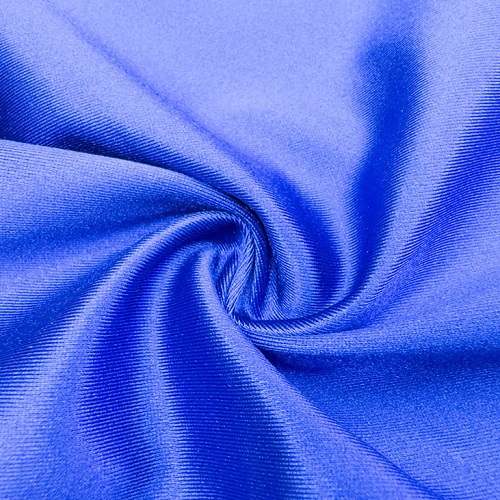In the fast-evolving world of performance apparel, fabric technology has become a defining factor in athletic wear innovation. Among the leading materials shaping the modern fitness and activewear landscape is Stretch Polyester Satin Fabric — a sophisticated textile that merges aesthetics, durability, and functionality. This fabric type represents the intersection of engineering precision and comfort design, offering a smooth, lustrous surface with high mechanical stretch and resilience suitable for fitness applications, dancewear, yoga apparel, and compression garments.
The backbone of stretch polyester satin fabric is polyethylene terephthalate (PET), a synthetic polymer derived from petroleum-based monomers — terephthalic acid and ethylene glycol.
To impart elasticity and recovery, spandex (elastane or Lycra) is blended or covered with polyester yarns. Spandex constitutes 5–20% of the total fiber content, depending on desired stretch performance. The elastic filaments allow bi-directional stretch, maintaining shape and compression even after repeated movement and laundering.
A satin weave is defined by long warp floats over multiple weft yarns (usually 4:1 or 5:1 ratios), producing a lustrous surface with a sleek hand feel. Unlike twill or plain weaves, satin minimizes interlacing points, allowing more yarn surface exposure, which enhances:
Knitted satin structures are also common, providing four-way stretch superior for dynamic movement in fitness applications.
| Property | Typical Range/Performance | Functional Impact |
| Elongation (warp/weft) | 20–60% | Provides flexibility during movement |
| Recovery rate | >90% after 100% elongation | Maintains garment shape |
| Tensile strength | 250–400 MPa | High durability under stress |
| Abrasion resistance | Excellent (>20,000 rub cycles) | Ideal for activewear longevity |
| Moisture regain | 0.4–0.6% | Fast drying and sweat management |
| Thermal stability | 150–180°C | Safe for most garment finishing processes |
| Air permeability | Moderate | Balanced between breathability and compression |
| Gloss level | 80–100 GU (gloss units) | Aesthetic sheen for premium fitness apparel |
Polyester’s crystalline molecular structure makes it resistant to many dyes; hence, disperse dyeing at high temperatures (130°C) in a pressurized environment is required.
Although conventional polyester is petroleum-derived, recycled polyester (rPET) derived from post-consumer plastic bottles has become increasingly popular. When combined with bio-based elastane and low-impact dyeing processes, stretch polyester satin can achieve 30–50% carbon footprint reduction compared to virgin fibers.
While classic satin is woven, the demand for four-way stretch has led to warp-knitted satin constructions using tricot or Raschel machines. These structures offer:
Post-knitting, the fabric is heat set under controlled tension (typically 180°C for 30–60 seconds). This process:
For premium performance wear, PU or silicone coatings may be added to improve durability, water resistance, and compression characteristics without sacrificing stretch.
Manufacturers also incorporate digital sublimation printing to add vibrant, long-lasting graphics, thanks to polyester’s compatibility with sublimation dyes.
Performance grades are established according to the specific garment’s functional requirement — compression wear, yoga wear, or outerwear.
Emerging smart textile technologies may also integrate conductive coatings or moisture-sensing yarns into stretch polyester satin fabrics, turning them into interactive fitness materials capable of tracking biometrics or adjusting compression dynamically.
Stretch Polyester Satin Fitness Fabric exemplifies the next generation of performance materials — combining strength, elasticity, moisture control, and elegant aesthetics. Its unique satin weave delivers a refined visual appeal while the polyester-spandex matrix ensures durability and freedom of movement, meeting the rigorous demands of modern fitness enthusiasts. With ongoing advancements in sustainable fiber engineering and functional finishing, this fabric is poised to remain at the forefront of athletic and athleisure textile innovation.
